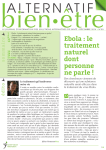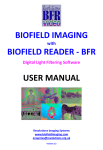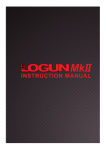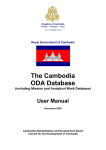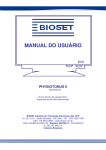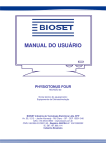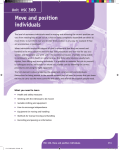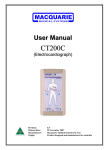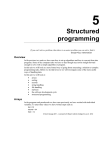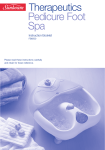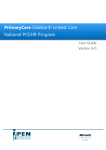Download OWNERS MANUAL
Transcript
Guide to obtaining the maximum benefits from your personalised Hydrotherapy System OWNERS MANUAL MULTIPOINT HYDROTHERAPY for Kaldewei Baths A-Z of Hydrotherapy Copyright (c) PH Pool Services Limited 1997 All rights reserved. No part of this publication may be produced or transmitted in any form or by any means, or stored in any retrieval system of any nature without prior written permission of the publishers. Published by: Bathe 25 John Street, Leichhardt, NSW, 2040 Australia Approved by the Chartered Society of Physiotherapists and the Oxford School of Chiropractic Ltd MULTIPOINT HYDROTHERAPY Preface We hope you will find this guide to obtaining the maximum benefits from your Hydrotherapy System of interest. Before purchasing a Hydrotherapy or Whirlpool System, the following points should be carefully considered. 1. Power - without sufficient power, therapy and benefits will not take place. Ensure that your pump is supplied to the Australian standard of safety and insulation P55. This should be stated on the motor and in the system specification. 2. Positioning - demand back and foot jets - these are the most important and without them 70% of the benefits would be lost. The more jets there are, the more effective the system will be as more of the body will be covered. Back Jets - in general, these should lie on either side of the spine because massage action is more beneficial to muscle and tissue than the bone. Some systems now offer a ‘Custom Build’ service where jets can be installed to your particular requirements and needs - ask your retailer for more details. 3. Hygiene - the Hydrotherapy/Whirlpool System must drain away dirty water left in the system and pump after each use. Rigid pipe is essential for this; avoid flexible pipes which are prone to sagging. 4. Pipe-work and Jointing - guarantees ensure a high quality finish and workmanship to a system. CONTENTS MultiPoint User Instructions Page MultiPoint System Diagram 1 Operating Instructions 2 MultiPoint Controls 2 Caution 2 Caring for your MultiPoint Hydrotherapy Spa Bath 3 Sanitisation of your MultiPoint System 3 Practical Hydrotherapy 4 Keep Fit in the Bath 4 Fault Finding Guide 5 Utilising MultiPoint Hydrotherapy Introduction to your MultiPoint Hydrotherapy System 6 General Health and Well-being 6 Mind and Body 8 Contra-Indications/Dangers 8 Positive changes experienced through the use of the Hydrotherapy System 9 Positive changes experienced with Customised Hydrotherapy Massage 10 Water Temperatures 10 Sports Activities 11 A - Z of Hydrotherapy A - Z of Hydrotherapy 12 Hydrotherapy Diagrams 17 Hydrotherapy - A Seasonal Guide 22 Pump air tube connection nipple. On/Off connection line. On/Off button (position will vary). Pump outlet - connect to 25mm jet supply pipework. Pump inlet - connect to spas 40mm suction pipework. Multi Jets. The Pump can be fitted upto 1.5 metres away from the bath. 10-16 Jet Systems need a 10 AMP power point. Air, aromatherapy and sanitising control knob (position will vary). MULTIPOINT USER INSTRUCTIONS MultiPoint System Diagram 1 MULTIPOINT HYDROTHERAPY Operating Instructions The water level in the bath must always be 5cm above the level of the highest jets, normally the back jets (allow for body displacement at 1 kg/litre). To activate your MultiPoint System after filling your bath, press the on/off button on or near the bath rim. Push once for ‘on’ and push once for ‘off’. Located on or near the bath rim is the air controls knob, which controls the amount of air going through the system. Turn counter-clockwise to allow more air to enter the System thus giving more ‘power ’and a stronger massage. Your System must never be operated when the bath is empty as this may damage the pump - guarantees are invalid if this takes place. MultiPoint Controls On/Off Air Control + Sanitiser Dispenser Caution 1. Keep the suction fitting clear of any foreign matter. Persons with long hair should secure their hair to a minimum length and not let it get near the suction fitting. Multi Jet Plus and Eye Ball Jet 2. Do not leave children alone (as with any body of water). 3. Sponges, face-cloths and soap should not be used whilst the System is operating. 4. Consult your doctor prior to use if suffering from heart circulatory, kidney/ liver disorders, or if pregnant. 5. Do not use extreme temperatures for long periods of time. 6. Do not drink excessive alcohol before using your MultiPoint Spa. To reduce flow to minimum, swivel eyeball with thumb to closed position. With the thicker end of the jet outwards the water flow is at maximum. Should hair, etc. Become lodged behind vanes, simply swivel the eyeball around and the water flow will blow obstructions free. 7. See A - Z of Hydrotherapy for full details. 2 MULTIPOINT USER INSTRUCTIONS Caring for your MultiPoint Hydrotherapy Spa Bath Abrasive cleaners must never be used to clean the tub. After every bath, rinse out the tub with clear water and wipe with a damp cloth. To clean the tub more thoroughly on occasion, use a small amount of cleaning liquid. Afterwards, polish with a soft dry cloth. Stubborn dirt can be removed with warm water and liquid cleaner or with a damp cloth and soap powder. To remove hard water deposits, use a damp cloth and a 10% vinegar solution. When using chemical drain cleaners, follow the manufacturers instructions carefully. Rinse thoroughly with plenty of water. Sanitisation of your MultiPoint System Step. A - Open Air Control Every use - Follow steps A, B, C and D. A. Open Air Control by turning counter-clockwise and remove completely for sanitiser access. Turn Counter-Clockwise B. Add 250ml of proprietary brand spa cleaner to 2 litres of water and our into the dispenser. C. Allow 2 minutes to drain away. Note: Ensure bath waste is open. D. Pour 2 litres of clean water into the dispenser and allow to drain away. Step. B - Spa Detergent Domestic - Every month or as needed follow steps 1-7. Commercial - Every time the room is vacated follow steps 1-7. 1. Open Air Control by turning counter - clockwise and remove completely for sanitiser access. 2. Fill baths with water to cover jets - 5cm above the highest jet (normally the back jets). 3. For baths with up to 133 litres (30 gallons) capacity, add 250ml of any proprietary brand spa cleaner. Step. 3 - Close Air Control For baths of greater capacity, increase dosage by 2ml per litre of water. 4. Close down air control for minimum agitation by turning clockwise and run circulating pump for 2 minutes. 5. Turn off pump and let water stand for 10 minutes. Turn Clockwise 6. Drain bath completely, then refill with cold water and run pump for a further 2 minutes. 7. Switch off, drain and empty. Also, carry out this procedure if the bath has been empty for a long period. 3 MULTIPOINT HYDROTHERAPY Practical Hydrotherapy This is based on a person being of reasonable good health and fitness and is not to be used as a strict guide. The information has been collected from medical and other sources. Sprains and stretched ligaments - Jet Pressure: Medium - High. On a particular limb or area, start with cold water and work up to warm. This stimulates the blood flow and regenerates the affected area. If possible keep the affected area as close to the jet as possible but not touching - particularly good for ankle, wrist and finger strains. Bruising - Jet Pressure: Low - Medium. On a particular limb or area, start with cold water and work up to warm after affected area has become settled. This will enable the exudate (surrounding fluid) to become more readily absorbed into general circulation. Arthritis and rheumatism - Jet Pressure: Low - Medium. Pain can be relieved by using tepid to warm water. Post orthopaedic therapy - Jet Pressure: Low - Medium. Over 55 years of age, use warm water to mobilise underlaying tissue and energise circulation and muscle tissue to become active. Under 55 years of age, use tepid water. This tremendously speeds up the healing process. Several neurological conditions and specific areas of complaint or ill health can be helped by using your MultiPoint System. Advice should be sought from Physiotherapist/Consultant. Keep Fit in the Bath The physiological changes which occur in the body appear to be triggered initially by weightlessness and by the transference of heat from the water to the body. In an ordinary bath, a film of water hugs the body, quickly cooling to body temperature. This effectively prevents the transference of heat and therefore does not stimulate the physiological changes. MultiPoint with its circulating, massaging water, breaks up this ‘wet suit’ effect and allows for the immediate and effective transference of heat into the body. The level of protein haemoglobin was measured during tests. This is an invariable substance, so changes in its concentration reflects changes in the fluid content of the blood. It was found that within half an hour, a drop of up to 20% was measured. This indicates the movement of fluid into the blood from the body tissues, it appears that the fluid in the joints is returned to the blood and toxins are therefore neutralised. This is of particular benefit to those suffering from diseases such as rheumatism and arthritis. The fluid movement to the blood also serves to dilute hormone levels. The stress hormones, adrenalin and noradrenalin are a measure of the total activity of the nerves in the body. The presence of these two hormones can result in an upward spiral, causing more and more to be produced. The dilution effect serves to break the stress spiral, thus switching off hormone production and creating a truly relaxing and pleasurable sensation. The salt retaining hormones are also suppressed, causing a diuretic effect which has beneficial implications for gout, kidney disorders, diabetes and cirrhosis. It was found that all therapeutic benefits were achieved at the temperatures between 35°C and 37°C. At 37°C, Cardiac output is increased by up to 100%, because the heart works more efficiently and effectively. This gives the heart as much exercise as it would get through sport activities. However, there is no (or very little) increase in heart beat so there is no extra stress on the body. This increase in cardiac output also has a slimming effect, since it stimulates the blood sugar and therefore lessens the desire for food. The effect of weightlessness on the body is also significant. It appears to cause the muscular band surrounding the arteries and veins to relax. This serves to increase the ‘bore’ or diameter and means the blood flows much more easily. This weightlessness helps pressure related pain, such as low backache, soft tissue injuries, joint diseases and fracture recovery. 4 MULTIPOINT USER INSTRUCTIONS Fault Finding Guide SYMPTOM Pop up plug operating incorrectly. Pump does not start. Pump starts then stops. Pump stops during normal operation. Leaks. PROBABLE CAUSE 1. Screw not adjusted. CURES 1. Adjust screw under plug as necessary. 1. Bathe master voltage conditions (power light is flashing on the touch pad). 2. Pump in lock-out mode (a light on the touch pad is flashing). 1. Pump has not achieved prime. 2. Pump has lost prime. 1. Periodically retry “Jets” button as unit will start to work once voltage supply returns to an acceptable level. 2. Wait for all flashing lights on the touch pad to stop, then activate the “Jets” button. 1. Pump has lost prime. 2. Pump has cut out on low/ high voltage conditions. (power light is flashing red/ green touch pad). 1. From socket union. 2. Other 1. Ensure pump and suction line are clear of any blockages. 2. Ensure the water level is at least 50mm above the height of the Jets. 3. Ensure there are no leaks in the suction line. 1. Strengthen base or make more secure. 2. Check pump height diagram and adjust by raising or lowering pump base to height. Pump to bath pipe connection should marry without strain on pipe work. 1. Undo union and ensure O ring is in place, then tighten. 2. Call service engineer. 5 MULTIPOINT HYDROTHERAPY Introduction to your MultiPoint Hydrotherapy System Medicine today is gradually rediscovering the truth that was taken for granted hundreds and even thousands of years ago, but was gradually ‘lost’ as a Western Man in particular began to apply a scientific way of looking at health and disease: the truth that mind and body are indistinguishably linked. Illness or disease can therefore be influenced on any one of three levels: a) anatomical e.g. by surgery b) physiological e.g. by drugs, acupuncture, homeopathy c) psychological and emotional Although one approach may be appropriate in any specific disease, it follows that intervention on any of these levels will have some effect on healing. Rather than seek to cure illness, we can therefore prevent much illness by intervening at an early physiological, psychological or emotional level. If this can be done by ourselves, in our own homes, at the time of our choosing, then so much the better. Hydrotherapy enables us to enjoy the benefits to health and general wellbeing through:a) general relaxation and massage b) specific treatment of individual areas and conditions The links between various illnesses and specific psychological states are becoming increasingly understood. We are often not aware that the attitudes, beliefs or negative thought patterns within cause disease; but they often ‘run’ our lives for us, bringing frustrations and unhappiness. Such emotions may be anger, criticism, resentment, guilt or unexplained fear or anxiety. It is much easier to become aware of; and then release, these negative attitudes when we give ourselves time for reflection, and are relaxed in body and mind. The use of hydrotherapy can help us achieve both. General Health and Well-being Our minds and bodies are affected daily by the stress and pace of modern living, and by the constant stimuli, whether they be noise, images from T.V. or advertisements. We are often conditioned to achieve more than is perhaps comfortable, and (often) in childhood) to please others and not think too much of ourselves. All this affects our general level of muscle tension, the rate and rhythm of our breathing, and the stillness of our minds. Some of the effects of this can be shown diagrammatically thus:Shallow/Irregular Breath Muscle Tension Chronic tiredness, Malise, Headache, Migranes, General stiffness of joints & spine (Lumbago), Decreased Mobility, Fibrositis (Fibromyalgia), General Aches & Pains Over drinking Tight Chest or Throat, Giddiness & and Tingling in Hands Anxiety, Scattered Thinking, Poor Concentration & Insomnia 6 UTILISING MULTIPOINT HYDROTHERAPY From this, it is clear that great benefits can come about improving our general relaxation. The fact that muscle relaxation, breathing, and our mental activity are directly linked means that improvement can be brought about by change in any one (or all) of them. Hydrotherapy is effective in this way: physiological changes in the body seem to be triggered initially by the buoyancy effect of water and the transference of heat into the body. In a ordinary bath, a film of water hugs the body, quickly cooling to body temperature. This ‘wet suit’ effect effectively prevents the transference of heat into the body. Hydrotherapy, with it’s circulating currents, breaks up this film and allows for immediate and effective transfer of heat, relaxing tense muscles and increasing blood flow to tissues. The warmth has a seductive effect on nerve endings and therefore reduces pain and discomfort. The buoyancy effect eliminates the effect of gravity and allows for more freedom and comfort of movement of joints and muscles. Because of this, the jet pressure gives a deeper effect, while the pressure of the water helps to eliminate oedema (fluid swelling) in the tissues. This pressure also has effect on the light and deep touch receptors in the nerve endings, helping to distract the pain carrying fibres from passing their ‘painful’ messages to the brain. The pleasant sensation actually helps ‘block out’ the passage of painful impulses. The pressure also tends to release endorphins, the same pain-killing substances that are released by vigorous exercise, massage or acupuncture. In general, cold to tepid water is good for swelling; too much heat makes it worse. Cold water stimulates circulation to the tissues and reduces swelling; this attracts more ‘repairing’ cells to a site of injury and promotes healing. The mechanical effects of hydrotherapy are therefore:a) to stretch the tissues b) to stimulate the circulation c) to disperse fluid (e.g. blood or lymph) These are of value in sport, for instances, for the treatment of cramps, muscle spasm or stiffness, deep or superficial scarring, oedema (inflammatory swelling) or deep bruising. The stimulation of the circulation occurs without increasing the ‘effort’ or rate of the heart. In consequence there is less strain on the heart muscle, an improvement in problems related to poor circulation, an improvement in skin tone, and a reduction in the stress hormones circulating in the blood stream. The result is an increase in relaxation and general well-being. The sensory effects are more complicated but are of two main types, reflex and psychosomatic. a) Reflex The effects occur via the sense receptors in the nerve endings and do not depend on one’s conscious sense. These lead to changes in the superficial and deep blood flow to the tissues, and changes in muscle tone. b) Psychosomatic The effects are due to one’s conscious awareness of the sensations brought by hydrotherapy. Massage in any form is a stimulus, which if given for a short period can refresh a limb or joint which is stiff or tired. More prolonged exposure, however, will depress one’s response, reducing sensory distractions and leading to a relaxation. This applies to one’s whole body, just as much as a part of it. This means that brief use of hydrotherapy can be used pre-sport to warm-up, invigorate and lessen the risk of injury (immediately before a game). After vigorous exercise hydrotherapy is a benefit in promoting recovery and preventing subsequent stiffness. (This is because the greatly increased blood flow to exercised muscles may cause fluid to ‘spill out’ into the tissues, which may then become swollen, tense and stiff). Hydrotherapy will promote the return of flow to the lymph and drainage of waste products from the muscles, hastening recovery. In injury, pain and muscle tension are virtually synonymous as nature seeks to prevent movement in a damaged limb by causing the local muscles to tighten up and provide ‘natural splinting’. It is this spasm which is the cause of most of the pain. Reduction of the spasm with gentle pressure is therefore sought until the local muscles and the body as a whole are suitably relaxed. A more direct approach is then possible, with higher pressures, to disperse 7 MULTIPOINT HYDROTHERAPY local collections of fluid (blood or lymph) at the site of injury and to produce mechanical effects on the tissues themselves. In acute injury, avoid direct pressure, for 48 hours as the tissues are vulnerable to further damage; seek only to induce general relaxation and reduction of muscle spasm initially. This does not apply in simple stiffness due to over-use when there is no direct injury. Following any injury, chemical substances released from damaged tissues cause local irritation and swelling (oedema), which may be increased by bruising when blood vessels are damaged. This causes pressure which leads to pain. The water pressure of hydrotherapy spreads the oedema and increases the area of absorption. This disperses the swelling and reduces the pain, even if the tissues are not yet healed. It is useful to try to work the swelling away from the centre of the injury (along the length of muscle, if within a muscle, or outwards in all directions if within the soft tissues). This applies to muscle stiffness, muscle sprains and bruises. Mind & Body In recent scientific literature there has been a growing awareness and acceptance that the mind can and does affect the state of the physical body. Now, unlike thirty years ago, very few doctors would argue against the statement that ‘Mental stress can cause physical disease’. Past emotional or mental pain and stress can create a distortion in our bodies, usually by the over tightening of muscles. Often, we fail to release these points of tension even after the emotional or mental cause has been resolved. Constant stress from work, family problems, etc. will lead to a huge decrease in flexibility and ease of movement in our bodies, which in turn causes a distortion in posture. This interferes with efficient working of the body systems, causing stiffness in the joints, tense sore muscles and congestion, or even malfunction of an internal organ. Hydrotherapy offers an excellent way in which to regain and maintain a relaxed, healthy and pain-free body. A body in a state of ease and balance can significantly help us to handle an often over-stressed modern life. Contra-Indications/Dangers Any form of massage, including hydrotherapy, should be avoided where there is infection or thrombosis, or around a malignant tumour. Hydrotherapy should be avoided (unless under medical supervision) in conditions involving: After a heavy meal Massage and heat will interfere with the digestive process and may cause vomiting or fainting - wait for a minimum of two hours before using the hydrotherapy system. Medication Discuss with your doctor the safety of hydrotherapy treatment used in conjunction with your prescribed medication before using the hydrotherapy system. Under the influence of alcohol/ non prescribed medicine It is unsafe to use the hydrotherapy system while under the influence of alcohol. Poor Peripheral Circulation It is unsafe to use the hydrotherapy system while suffering painful cramps on walking, leg ulcers, or diabetic foot problems. Severe and Recent Bruising It is unsafe to use the hydrotherapy system with recent bruising as it may increase swelling and bleeding tissues. The following list of symptoms and signs may help in identifying the conditions described. If suspected, medical advice should be sought. Rheumatoid Arthritis The acute early stages, or later flare-ups (i.e. When the joints are hot and swollen). Infections/Inflammations Hot, red, swelling, tenderness and pain, often throbbing. 8 UTILISING MULTIPOINT HYDROTHERAPY Thrombosis - (deep vein) Swelling, sometimes hot, sometimes congested and blue, sometimes pale and shiny. Hard and tender muscles; pain on stretching and walking. Usually sudden onset with no history of injury. Circulation Problems Avoid heat in limbs with poor circulation; the increased metabolism may exceed the blood supply and increase the risk of tissue breakdown and the formation of an ulcer. Tumours Firm or hard swelling, often not painful, or painful at night or at rest. UNDER SUPERVISION Epilepsy/ Spasticity - the feedback on benefits received for children with these conditions have been very positive, but for safety reasons, stress the need for supervision. BACK JET(S) Swelling, sometimes hot, sometimes congested and blue, sometimes pale and shiny. Hard and tender muscles; pain on stretching and walking. Usually sudden onset with no history of injury. Avoid heat in limbs with poor circulation; the increased metabolism may exceed the blood supply and increase the risk of tissue breakdown and the formation of an ulcer. Firm or hard swelling, often not painful, or painful at night or at rest. It is inadvisable to direct massage action on to the spinal column itself; where there has been injury, recent surgery, or prolapsed disc problems. Care should be taken where there is a skin condition such as eczema, psoriasis, pressure ulcers or dry and cracking skin. Elderly users should take care not to have a powerful jet centred on the spine. The ideal positioning of back jets to all situations is to either side of the bony spinal column as shown in (Figures 3 and 4 Page 18). Where bruising, ligament sprains and tears have occurred several short periods of massage action are beneficial, rather than leaving the whirlpool in action for a long continuous period. Positive changes experienced through the use of the Hydrotherapy System When under stress (whatever the cause) the chemical changes in the body can cause the blood pressure to rise and the pulse rate to become faster than normal, which can cause symptoms like palpitations, panic attacks, anxiety, etc. Having regular hydrotherapy treatments can reduce these symptoms by slowing down the process of stress reaction, as the warm water and sensation of the passive massage allows the body to relax and unwind under the custom-built jets positioned for your particular body shape and condition. AT THE FIRST TREATMENT: After five minutes: Blood pressure and pulse rate return to normal. (Normal adult resting pulse = 60 - 80 beats per minute and blood pressure 120 over 70mm). After ten minutes: Circulation improves in hands and feet, making them warmer. After fifteen minutes: The muscles relax and become more receptive to passive exercise; fibrous tissue becomes more pliable and responsive to stretching, encouraging the release of lactic acid and other toxins from the system. After twenty minutes: Aches and pains experience a decrease in severity. AFTER THREE TREATMENTS: The immune system is improved 9 MULTIPOINT HYDROTHERAPY AFTER FIVE TREATMENTS: Emotional stress and physical tension are noticeably reduced. AFTER TEN TREATMENTS: Pain relief is longer lasting and there is a greater sense of well-being. AFTER TWENTY TREATMENTS: There is a heightened resistance to disease and depression. The skin is clearer and ‘glows’ with health. Muscle tone and mobility improves. Positive changes experienced with Customised Hydrotherapy Massage IMPROVED CIRCULATION Increases blood flow Brings fresh oxygenated blood and other nutrients to the cells, removes waste products and destroys invading bacteria and viruses (such as gut infections, colds, flu etc.) with its white corpuscles, encouraging a healing process. Stimulates the flow of Lymph The lymphatic system has no pump to circulate it through the body and relies on movement of muscle to propel it. A healthy flow of lymph helps to maintain the correct fluid balance in the tissues, to defend the body against disease, conserve protein and to remove waste products. IMPROVED MOBILITY Correct Jet Positioning is Essential Provides passive exercise Improves muscle tone. Provides localised massage Relieving tension, emotional or physical discomfort. Relieves Pain Passive exercise and localised massage using the hydrotherapy system, stretch the fibrositis tissue, improving mobility of joints and muscles, relieving cramp and fibrositis, and speeding recovery time of muscle or ligament tears and sprains. CLEANSING THE SYSTEM Softens and stimulates the skin Stimulates the sweat glands, eliminating waste (sweat is a mixture of water, salts, uric acid, amino acids, sugar, lactic acid and ascorbic acid). Skin is the organ of touch. It communicates messages of relaxation or stimuli via the peripheral nerves to all of the bodies organs, while eliminating waste and regulating the temperature of the body. These positive changes and benefits culminate in a general feeling of well-being Water Temperatures Hot 37°+ C (98°+F) Use for short periods, i.e. maximum of 5-10 minutes, jet pressure low to medium. Results: increase in blood flow, circulation and relaxation. Avoid use for long periods of time in severe/recent bruising and in circulation disorders. Warm 36°C (96 - 97°F) Use for 10-15 minute periods. Jet pressure medium to high. Results: increased circulation and skin tone, easing of tense and tired muscles, relief from tension and stress, dispersing of fibrositic nodules, relaxation of the whole body. Tepid 35°- 37°C (93°- 95°F) (Body gains heat above 93°F) Use for 10-20 minute periods. Jet pressure medium to high. Results: relief from insomnia, increased circulation and skin tone, improving muscle tone thus firming shape. Helps reduce flab on thighs and waist. 10 UTILISING MULTIPOINT HYDROTHERAPY Cold Below 34°C (93° F) Use for 5-10 minute periods, or for as long as is comfortable. Results: excellent for increased circulation to stretched, over-used muscles. Invigorating and refreshing. It is particularly refreshing and energising to start with warm water and medium to high pressure jets and leave cold water tap on to cool water gradually until the temperature becomes uncomfortable. (Water level is maintained by overflow fitting). TREATMENT OF SPECIFIC CONDITIONS It is useful to apply water pressure locally as described above. This can be refined by applying a fine jet to the specific ‘trigger’ points round joints or in the muscles. These are so named as they are very tender to direct pressure, and often coincide with the Acupuncture points described in Chinese medicine. Tender or ‘crystalline’ areas on the soles of the feet may be related to problems in other parts of the body, such as the spine in back pain, and pressure applied to these may prove helpful. (See Reflexology Chart Page 21). In the following A - Z, some local points are shown well as a few distant points useful in certain conditions. The figures referred to are on pages 17 to 21. In addition it is helpful, as mentioned earlier, to consider various emotional and mental states that can often underlie specific conditions, and learn to change them. Sports Activities The Hydrotherapy system is a relaxing and passive way to warm-up before a match or practice session, conserving energy for the game or competition itself. For all sports, start with warm water and medium to high pressure, customise water jets and leave cold water tap on to gradually cool water until the temperature becomes uncomfortable. This will invigorate and stimulate the muscles, before play. Football - Concentrate on lower back (for the twisting and turning of direction during play) thigh jets (to assist quadriceps), calf jets (for gastrocnemius/soleus muscles) and ankle and foot jets (for toes) to prepare for sprinting action during play. The shoulder jets will help warm-up neck muscles before heading the ball, and the goalie will benefit from the thigh jets aimed at the torso (latissimus dorsi muscles) to assist diving for the ball. Squash - Players will benefit from using the hydrotherapy system as for footballers but concentrating more on the calves, before a game, to build up speed and muscle strength. Tennis - Players should pay particular attention to using jets for their shoulders and wrists, which can bear considerable strain from heavy hitting serves and returns. Hydrotherapy before a match or practice session will loosen joints and make movement more supple, open and flowing. Pay particular attention to shoulders, neck, glutes and calves. Cricketers - will need to concentrate on using customised jets for elbows, wrists, thighs and calves, with bowlers paying particular attention to opening up the shoulder girdle, with high pressure shoulder jets, for maximum freedom of movement. Golfers - should pay attention to the region of their lower back, hips, shoulders and wrists by applying high pressure customised water jets accordingly. Using the highest back/shoulder jets directed at them 45° towards the upper trapezius muscles to alleviate the strain that the golf swing creates by the head and neck remaining static while the shoulders rotate. Finish with a cold water session to ‘lock’ heat inside the body before competing in cold weather. Weight lifters - need to concentrate on their shoulders, back, hips, thighs and ankles particularly after competition when the body has endured considerable strain! After all sporting activities, a twenty minute session of medium to low pressure warm water jets will relax the body and increase lymphatic drainage and remaining build-up of lactic acid from the muscle tissue which in turn reduces stiffness sometimes suffered later on, and stretch any tense muscles. Reduce the temperature before getting out to reduce the risk of light headedness. 11 MULTIPOINT HYDROTHERAPY A - Z of Hydrotherapy CONDITION COMMENTS Angina Various causative factors may be involved. Relaxing in the buoyant atmosphere of the hydrotherapy system will relieve the stress related factors which play a part in this disease. Water temperature must never be higher than 37°- 38° (body temperature) while cool low pressure jets (under supervision) will improve blood circulation and muscle tone. Use shoulder, back and foot jets. Aches and Pains Use warm low/medium pressure, shoulder, back, hip, thigh, calf, ankle and foot jets. Arthritis Low/medium pressure. Tepid-warm water. For large joints, treat the points indicated in the diagrams. Rheumatoid Arthritis In acute stages, when joints are hot and swollen, use only cool, low pressure, under supervision. Osteo-arthritis Low/medium pressure. Tepid or warm. Ankylosing Spondylitis Immersion in water aids stretching, mobility, and muscle relaxation. Anxiety Warm, low/medium pressure. Particular foot jets directed at Solar Plexus Reflexes. Back Pain One of the most common physical causes of inability to work, affecting the ‘white collar’ worker, the ‘blue collar’ worker, the labourer, the typist and the housewife alike. Back pain will affect 80% of us at some time in our lives. The spine is our physical support and closely related to our ‘standing’ in life, our attitudes (rigid or flexible) and our sense of security and belonging, especially to our sense of being supported, whether by family, colleagues or employees. The spine consists of bones (the vertebral bodies), separated by the ‘shockabsorbers’ - the vertebral discs. The vertebrae are also connected by joints behind and supported and held into position by muscles and ligaments. In a healthy spine, all the parts function as a unit. Each vertebrae being able to tilt forward and back, and also rotate in either direction on the ones immediately above and below. The spine also contains and protects the spinal cord and the main nerve highway of the body, supplying connections from the brain to the whole body; these enable us to move, to feel pain, pleasure, temperature and touch, and enable the working of the body and all its different organs to be controlled and co-ordinated. The efficient functioning of the spine is hindered by: a) Poor posture, often related to chronic stress, whether mental, emotional or physical, and also to depression. b) Damaged spinal muscle or ligaments, resulting in an imbalance of the spine through muscle spasm. This is more likely to occur in a person who is nervous, tense, fatigued or depressed and most likely to catch the body unprepared, with resulting injury. c) Pressure on nerve roots by a prolapsed disc (sciatica) or by swelling in the tissues from inflammation due to injury. 12 A-Z OF HYDROTHERAPY Hydrotherapy can help in the following ways: 1) Preventative By gradually reducing the effects of stress, tension and fatigue and toning the spinal muscles, the risk of injury is lessened. 2) Curative By acting locally on injury tissues, lessening inflammation and oedema and diminishing reflex muscle spasms, it helps reduce pain. By improving the blood supply, repair and healing is accelerated. By eliminating the effect of gravity, pressure is removed from the disc and joints and stress on the supporting muscles and ligaments is lessened. (Cold water is helpful with inflamed, tender tissues, and warm water with injuries with swelling or accumulation of fluids, and with painful spasm). Back pain (upper) Treat upper points as in Point M (Figure 3. Page 18) and other tender points. Warm low/medium pressure. Shoulders, back and foot jets. Back Pain (middle) Treat local points (Figure 2. Page 17) Back Pain (lower) (lumbago) Treat local points (Figure 2. Page 17), E and M (Figure 11 and 12. Page 20) full set of jets. Particularly lower back, hip, thigh and foot jets. Colic (Flatulence) Excess gas, abdominal distension/discomfort, caused in the main by diet (e.g. eating fruit with other foods that take longer to digest will cause the fruit to ferment in the gut). Medium pressure, hot water jets applied locally while massaging the abdomen with the palm of the hand in a clockwise direction, can relieve the pain and discomfort of colic. It will also improve peristaltic action thereby relieving constipation. Try rolling onto side, using thigh jets for maximum effect. Constipation As for colic use massage Points N (Figure 10. Page 19). Cramps A cramp is a painful spasm which results from excessive contraction of the muscle fibres and usually occurs during or after exercise, due to a build up of lactic acid in muscles. The jets will gently massage the affected part, relieving the cramp by stimulating blood circulation and flushing out lactic acid. It also prevents the muscles becoming stiff later. Commonly, calves and thigh jets can be useful here. Degenerative Joint Disease See Osteo-arthritis. Elbow (‘tennis’) Tepid-warm. Medium pressure to local points (Figures 5, 6 and 7. Pages 18 and 19). Shoulders and back jets together with foot jets directed at the outer edge of feet. Computer Keyboard Symptoms Head and chin tend to ‘jut’ forward leading to compression of the joints and structures of the neck, in turn hindering efficient circulation and nerve conduction in the arms. Shoulder and upper back jets are crucial to ease symptoms. Lower arms suffer from static muscle contraction and hydrotherapy will assist lymphatic drainage in this area, thereby reducing congestion in tendons and muscles and decreasing the possibility of inflammation. (See Figures 5 and 6. Page 18) Interosseous Membrane . Energy/Exhaustion See Post Viral Fatigue Syndrome and Immune System as for general relaxation. Also both N Points on both limbs (Figure 10. Page 19) which is helpful in increasing levels of energy. Try foot jets directed at Solar Plexus, Head and Spine Reflexes. Fatigue See Tiredness. 13 MULTIPOINT HYDROTHERAPY Fibrositis (fibromyalgia) As for general relaxation. Treat local tender points. Warm medium pressure. Full set of jets giving total body coverage. Gout Cold - cool. Low pressure - helps reduce the heat and pain. Headaches As for general relaxation. Treat neck points (Figure 1. Page 17). Use shoulder, back and foot jets; see Reflexology Chart for neck and head reflex points. High Blood Pressure (As for Parkinsons Disease). The regular massage from the hydrotherapy jets will reduce stress. Massage both N Points (Figure 10. Page 19), K3 (Figure 12. Page 20) and P6 (Figure 14. Page 20). Remember heat reduces blood pressure, and cold raises blood pressure, always finish by reducing the temperature of the water to reduce the possibility of fainting. Wrap up warm and allow yourself recovery time before (non-competitive) exercise. Shoulder, back, hips, calves and foot jets are recommended. Hip Pain Treat local Points A, B, C, and D (Figure 8, 2 & 9 Pages 17 and 19). Shoulder, hip and ankle jets, and see Reflex Shoulder cross reflex. Immune System Alternating hot and cold water can have the effect of boosting the immune system. The blood responds to alternate temperatures by moving away from the body’s exterior (cold) and from deeper tissues (hot). This keeps the circulation ‘bouncing’ and will increase (temporarily) the white blood cell count, which helps the body’s disease fighting mechanism. To achieve this effect with your hydrotherapy system start with a temperature using the medium to high pressure jets. Use shoulder, back, hip and foot jets. Insomnia As for general relaxation. Treat local causes of pain if a factor . Full set of jets, especially foot jets. Involuntary Muscle Spasm This can manifest in a number of ways. Most commonly as a Cramp (in the limbs), colic (in the stomach/bowel) and Angina Pectoris (in the heart). It is important to have a doctor identify the area of concern before advising on Hydrotherapy treatment. Joints See Arthritis or sprains. Knee Pain (Chronic) Treat local Points E (Figure 11. Page 20) and anterior knee points (Figure 10. Page 19). Use foot jets directed at outer edge of foot. Ligament sprains/tears (mild-moderate) Start with cool water, work up to warm. Keep affected area close to jet as possible. Good for wrist, ankle, hand and finger strains. Medium to high pressure, but avoid latter if sprain is severe. Cold water jets (after plaster is removed). Use foot jets directed at outer edge of foot. Lumbago See low back pain. Use hip and foot jets. See Reflex Chart and direct foot jets at lumbar area of feet. Migraines As for general relaxation. Treat neck points, J (Figures 1, 2 and 8 Pages 17 and 18.) and L (Figure 9 Page 19). Use warm water. Foot jets directed at head, neck and shoulder reflexes. Muscles Tense, painful or injured muscles will respond to warmth, plus massage jets applied locally to tender points. Generally shoulder, back, thighs, calves and foot jets. 14 A-Z OF HYDROTHERAPY Myalgic Encephalomyelitis (ME) See Immune Systems and post Viral Fatigue Syndrome. Nerves See Anxiety. Nodules See Fibrositis. Neuroma Exquisitely tender, gritty nodules in ligaments (especially around joints). Prolonged cool, high pressure unitl discomfort eases. Osteo-arthritis See under Arthritis. Pain Relief Use warm strong pressure from cramped, tense and fibrositic muscles (especially shoulders and neck J). (See Reflexology Chart Page 21), as foot jets can be especially beneficial here. Use tepid-warm, low or medium pressure for long term aches and pains, e.g. in osteoarthritis of knees, hips and hands. Parkinson’s Disease If taking medication, blood pressure may be reduced by the medication; therefore the water should not be so hot as to reduce it even further. A temperature of 37°- 38°C will be high enough. Gradually reduce the temperature of the water with low to medium pressure jets before getting out. Take it easy by spending 10 minutes in the beginning and gradually increase the time spent in the bath to 20 minutes. Try Reflexology, directing the jets to work on the head and spine reflexes (See Reflexology Chart Page 21) together with shoulder, back and hip jets. Post Viral Fatigue Syndrome See Immune System. Use full set of jets. Pregnancy Ante-natal A Hydrotherapy system is ideal for the typical backache of pregnancy, but avoid hot water. Shoulder, back, hip, thigh and foot jets (See Reflexology Chart Page 21). Post-natal This supporting action of water and the massage jets, aid the re-toning of lax abdominal muscles. Thigh jets can be used while lying on the side. Relaxation Warm/gentle pressure - 15 minute minimum. The buoyancy effect to the water allows muscles to relax. Rheumatoid-arthritis The warm massage action soothes the nervous system and the body responds deeply to being immersed in this comforting environment. Full set of jets giving total body coverage especially foot jets. Sciatica See Arthritis/Aches and Pains. Shoulder/neck See Arthritis/Aches and Pains. Treat local points low back, Points A (Figure 8. Page 19) and E (Figure. 11 Page 20) warm gentle pressure. Recommended jets are hip, thigh and foot jets directed at heel and outer ankle. Treat neck joint, Point J (Figure 1, 2 and 8 Pages 17 and 19) and P (Figure 3. Page 18). Note that in many shoulder and neck problems, particularly when we are ‘shouldering’ too many burdens or responsibilities, tender points can often be found along the upper spine, or just inside the inner edge of the shoulder blade, Point B (Figure 2 Page 17). A ‘frozen shoulder’ where movement of the joint is stiff and painful will often respond to treatment of points Q and R (Figure 3. Page 18) and P (Figure 5. Page 18), and K1 and K2 (Figure 4. Page 18). Pain over the upper part and back of the shoulder blade can be improved by treating 15 MULTIPOINT HYDROTHERAPY swelling is apparent in acute injury, then use cold/gentle. Reinforce the above tips by using foot jets directed at relax points (See Reflexology Chart Page 21). Sinuses High/medium jets aimed at all toes of both feet, will help clear sinuses and the symptoms of head colds (for a more potent effect aim jets at web of fingers too). Skin Skin tone improved by relaxing effect of water which increases blood supply, followed by the stimulating effect of the cold. Under positive changes your body goes through with customised jets. Spasticity (Muscle Rigidity) usually treated with physiotherapy, however, may also be helped by the warmth of the water and the massaging action of the jets (under supervision). Use warm, low/medium pressure to start, building up to tolerance over a period of two or three weeks. The positioning of the jets will play a big factor in the success of the treatment, especially for Torticollis (wryneck). Use shoulder and back jets with foot jets on neck and shoulder reflexes (See Reflexology Chart Page 21) together with ankle jets which work on the cross reflex for maximum effect. Stiffness As for general and local muscle relaxation Stomach/Colitis As for colic use both massage points labelled N (Figure. 10 Page 19). Stress See Improved Mobility (Positive Changes your Body Goes Through). Tiredness (Chronic) As in Relaxation. To revitalise flagging energy for short periods only use warm/ medium pressure followed by cold/strong pressure. Full set of jets especially shoulder, back and foot jets. Toothache (Chronic) Consult your dentist. To ease the pain, massage points D (Figure 9. Page 19) for upper jaw pain, and K (Figure. 13 Page 20), for lower jaw pain. (See Reflexology Chart Page 21) and direct floor jets beneath all toes of both feet. Vulnerability to viruses Can be reduced by easing tension in the body and stress in the mind - warm/ gentle. See body/mind effects and Immune System. Wrist Treat local points. X For Xtra powerful, massaging jets. Y Y not install a hydrotherapy system, you deserve it! Z For Zest; after Y, you’ll have much more of it. Also for ZZZZ - a regular good nights sleep! 16 HYDROTHERAPY DIAGRAMS Figure 1. Figure 2. 17 MULTIPOINT HYDROTHERAPY Figure 3. Figure 4. Figure 5. Figure 6. 18 MULTI POINT HYDROTHERAPY HYDROTHERAPY DIAGRAMS Figure 7. Figure 8. Figure 9. Figure 10. 19 MULTIPOINT HYDROTHERAPY Figure 11. Figure 12. Figure 13. 3. Figure 14. 20 HYDROTHERAPY DIAGRAMS Reflexology Chart 21 MULTIPOINT HYDROTHERAPY Hydrotherapy - A Seasonal Guide Spring After the winter let hydrotherapy help you get back into shape. It will help you fight the flab, tone up your muscles, sooth away stiffness and invigorate you. Hydrotherapy will also help you recover from the effects of increased activity brought on by warmer days and lighter evenings. Use hydrotherapy to ease backpain from gardening, muscle strains from vigorous exercise and inflammation of joints from over-use. It will also help provide relief from lumbago. Summer Hydrotherapy is perfect for warming up, and in preparation for sporting activites, maintenance of muscle tone and suppleness, and for easing bruising and sporting injuries. Autumn As the weather turns cold and damp, hydrotherapy will help with those seasonal aches and pains, muscular rheumatism and arthritis in the joints. It will also help improve circulation. Winter Hydrotherapy offers a wonderful way to relax at the end of a gold grey winter’s day, as well as helping skin tone and soothing arthritic joints. After all this, remember that Hydrotherapy boosts the morale and is great fun. 22



























